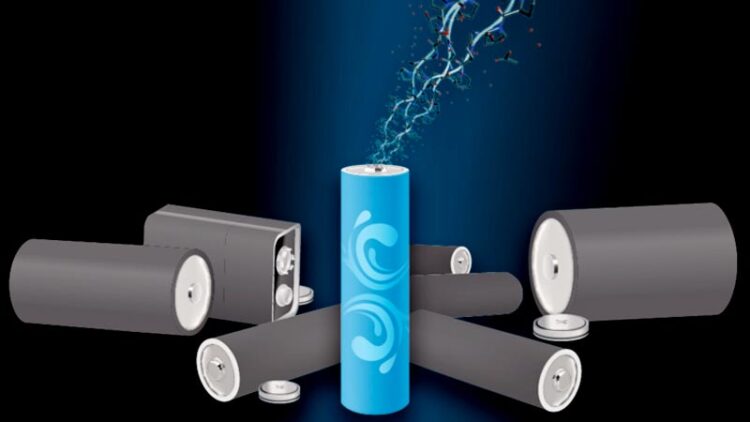Major storage capacity in water-based batteries

Chemical engineering professor Dr. Jodie Lutkenhaus and chemistry assistant professor Dr. Daniel Tabor have discovered significant storage capacity in water-based batteries.
Credit: Texas A&M Engineering
Texas A&M researchers discover storage capacity increase of water-based battery electrodes.
Researchers at Texas A&M University have discovered a 1,000% difference in the storage capacity of metal-free, water-based battery electrodes.
These batteries are different from lithium-ion batteries that contain cobalt. The group’s goal of researching metal-free batteries stems from having better control over the domestic supply chain since cobalt and lithium are outsourced. This safer chemistry would also prevent battery fires.
Chemical engineering professor Dr. Jodie Lutkenhaus and chemistry assistant professor Dr. Daniel Tabor has published their findings about lithium-free batteries in Nature Materials.
“There would be no battery fires anymore because it’s water-based,” Lutkenhaus said. “In the future, if materials shortages are projected, the price of lithium-ion batteries will go way up. If we have this alternative battery, we can turn to this chemistry, where the supply is much more stable because we can manufacture them here in the United States and materials to make them are here.”
Lutkenhaus said aqueous batteries consist of a cathode, electrolyte and an anode. The cathodes and anodes are polymers that can store energy, and the electrolyte is water mixed with organic salts. The electrolyte is key to ion conduction and energy storage through its interactions with the electrode.
“If an electrode swells too much during cycling, then it can’t conduct electrons very well, and you lose all the performance,” she said. “I believe that there is a 1,000% difference in energy storage capacity, depending on the electrolyte choice because of swelling effects.”
According to their article, redox-active, non-conjugated radical polymers (electrodes) are promising candidates for metal-free aqueous batteries because of the polymers’ high discharge voltage and fast redox kinetics. The reaction is complex and difficult to resolve because of the simultaneous transfer of electrons, ions and water molecules.
“We demonstrate the nature of the redox reaction by examining aqueous electrolytes of varying chao-/kosmotropic character using electrochemical quartz crystal microbalance with dissipation monitoring at a range of timescales,” according to researchers in the article.
Tabor’s research group complemented the experimental efforts with computational simulation and analysis. The simulations gave insights into the microscopic molecular-scale picture of the structure and dynamics.
“Theory and experiment often work closely together to understand these materials. One of the new things that we do computationally in this paper is that we actually charge up the electrode to multiple states of charge and see how the surroundings respond to this charging,” Tabor said.
Researchers macroscopically observed if the battery cathode was working better in the presence of certain kinds of salts through measuring exactly how much water and salt is going into the battery as it is operating.
“We did that to explain what has been observed experimentally,” he said. “Now, we would like to expand our simulations to future systems. We needed to have our theory confirmed of what are the forces that are driving that kind of injection of water and solvent.
“With this new energy storage technology, this is a push forward to lithium-free batteries. We have a better molecular level picture of what makes some battery electrodes work better than others, and this gives us strong evidence of where to go forward in materials design,” Tabor said.
The project is funded by the U.S. Department of Energy and the National Science Foundation through the Texas A&M Engineering Experiment Station.
By Raven Wuebker, Texas A&M Engineering
Journal: Nature Materials
DOI: 10.1038/s41563-023-01518-z
Article Title: The role of the electrolyte in non-conjugated radical polymers for metal-free aqueous energy storage electrodes
Article Publication Date: 27-Mar-2023
All latest news from the category: Power and Electrical Engineering
This topic covers issues related to energy generation, conversion, transportation and consumption and how the industry is addressing the challenge of energy efficiency in general.
innovations-report provides in-depth and informative reports and articles on subjects ranging from wind energy, fuel cell technology, solar energy, geothermal energy, petroleum, gas, nuclear engineering, alternative energy and energy efficiency to fusion, hydrogen and superconductor technologies.
Newest articles

Why getting in touch with our ‘gerbil brain’ could help machines listen better
Macquarie University researchers have debunked a 75-year-old theory about how humans determine where sounds are coming from, and it could unlock the secret to creating a next generation of more…

Attosecond core-level spectroscopy reveals real-time molecular dynamics
Chemical reactions are complex mechanisms. Many different dynamical processes are involved, affecting both the electrons and the nucleus of the present atoms. Very often the strongly coupled electron and nuclear…

Free-forming organelles help plants adapt to climate change
Scientists uncover how plants “see” shades of light, temperature. Plants’ ability to sense light and temperature, and their ability to adapt to climate change, hinges on free-forming structures in their…





















